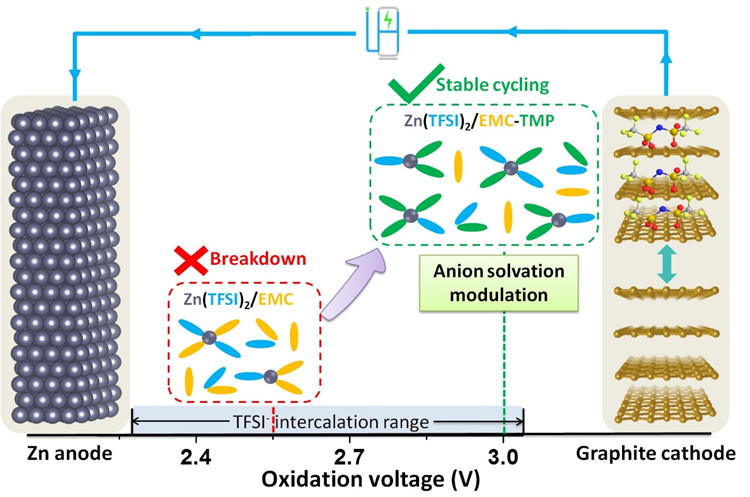With grid-scale renewable energy on the rise, many scholars have shifted their attention from energy generation to energy storage. Whether it is solar cells converting sunlight into power, or windmills transforming air currents into electrical currents, the sources of renewable energy generation are inherently variable. Exceptionally cloudy or still days can cause noticeable fluctuations in the power output of renewable sources. A major hurdle for grid-scale renewable energy is how to efficiently store these often intermittent energy sources for later, more evenly distributed uses.
A research team led by Prof. CUI Guanglei and ZHAO Jingwen from Qingdao Institute of Bioenergy and Bioprocess Technology (QIBEBT), Chinese Academy of Sciences (CAS) is one step closer to solving this storage problem. The team has focused on Zinc anode and Graphite cathode based Dual-ion batteries (DIBs) due to their low cost and high-voltage capabilities, making them a great candidate for large, grid-scale storage devices. They published their findings on August 18 in the peer-reviewed journal Angewandte Chemie’s international edition.
In these batteries, Zn deposition occurs on a Zn anode during charging process while negatively charged anions weave themselves into the Graphite cathode allowing energy storage for later use, a process known as intercalation. Zinc/Graphite batteries, however, do have a catch.
"Unfortunately, anions often used for graphite intercalation reactions could complex with carbonate in the electrolyte. This decreases the oxidation stability of carbonate and prevents the development of DIBs with high efficiency, low self-discharge and long shelf/cycling life," says CUI. Essentially, the electrolytes used to transfer charge through the battery would undergo oxidative decomposition at high voltage regions, lowering the efficiency and the lifetime of the battery. This is an essential problem to solve before applying this type of battery to large scale power storage.
The authors of the study described the group's approach as enhancing the oxidation stability of carbonate-based electrolytes through tuning the anion solvation structure. By introducing a strongly-electron donating trimethyl phosphate (TMP) solvent, the team was able to trap the anions in the TMP solvation regime and decouple the anions from carbonate solvent. Consequently, the operating voltage of the Zinc/Graphite batteries was raised by 0.45 V while also enabling a long-life cycle (92% capacity retention after 1000 cycles). This could not only extend the cycle life of Zinc/Graphite batteries, but also increase the capacity of anion intercalation into graphite. The authors went on to emphasize that "a deep understanding and regulation of the anion solvation structure is essential."
"Here, we regain the anti-oxidative nature of carbonate-based electrolytes to support high-voltage Zinc/Graphite cells, by reorganizing the intermolecular (ion-solvent and ion-ion) interactions," CUI said.
As for what's next, the authors provided a look at the path towards commercialized, high efficiency storage for renewable energy. Their future work will be focused on increasing the energy density, suppressing the self-discharge behavior as well as lowering the cost of the electrolyte for Zinc/Graphite batteries. The ultimate goal is to commercialize the Zinc/Graphite battery in grid-scale energy storage.

Fig.: Tuning the anion solvation network of carbonate-based electrolyte for high-voltage Zn/graphite batteries. (Image by ZHAO Jingwen)

